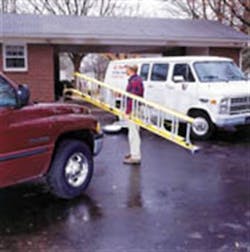Rugged revenue: Commercial LT tire segment continues to grow
Light truck tires used in commercial applications endure an extraordinary amount of abuse. They roll over rocks, rubble and other debris strewn across a wide range of inhospitable surfaces while suffering bumps, scrapes, scrubbing and endless pounding that would destroy tires of lesser construction. While medium and heavy truck tires get more ink, commercial light truck tires are every bit as hard working. And selling them can be just as profitable.
Tough as steel
One dealership that´s cashing in is Fayetteville, N.C.-based Briggs & Sons Tire. Danny Boahn, who manages Briggs & Sons Tire´s truck tire center in Fayetteville, reports that the company´s commercial light truck tire sales have been on the upswing.
Road construction is booming in the Fayetteville area with many building companies taking their big pickup trucks off-road. "The reason we sell these tires is because they´re hefty," says Bob Briggs, owner of Briggs & Sons Tire. "They won´t break down and leave the customer stranded."
The tires´ engineering keeps improving, according to Boahn. "I´ve been in this business for 13 years. Some of these (tires´) designs are just remarkable."
Most commercial light truck buyers "want a heavier construction tire," says Donn Kramer, Goodyear Tire & Rubber Co.´s director of marketing, Commercial Tire Systems. "Steel-belted fabric tires don´t hold up compared to steel-steel light truck tires. All-steel performs much better."
All-steel configurations emerged about 20 years ago, according to Kramer. Before that, steel-belted fabric tires dominated the segment.
All-steel commercial light truck tires weren´t immediately embraced by customers, he reports. It took about 10 years for the products to gain widespread acceptance. "When we first brought them to market, we treated them like they were consumer tires. That was probably the wrong thing to do out of the box." Now it has become standard practice throughout the industry to classify commercial light truck tires as true commercial products, says Kramer.
The commercial light truck segment has been growing by 6% to 10% each year, according to Goodyear statistics. The Akron, Ohio-based tiremaker expects it to grow by 6% to 8% a year "at least through 2008," says Kramer. "Traditionally, the market in total from 1998 through 2003 has averaged 2% to 9% (growth) per year."
Increased sales are attributable to activity in the housing construction market, he says, which, in turn, boosts the number of vehicles being used for related applications.
[PAGEBREAK]
Price, tread preferences
Briggs & Sons Tire sells Goodyear, Bridgestone and Michelin brand commercial light truck tires. However, Boahn reports that some of his customers in the building trade "are kind of getting away from major brand stuff and into private labels." He says the trend began three years ago when the economy soured after the Sept. 11 terrorist attacks "and has steadily increased. When money was tight, they started running lower-cost products. And the cost differential has kept them from switching back."
Briggs & Sons Tire´s construction clients prefer tires with versatile all-terrain treads, he says. But commercial light truck tires with highway tread patterns remain top-sellers as well, according to Phil Pacsi, executive director, North American consumer tire brand marketing, Bridgestone Firestone North American Tire LLC. Highway patterns contain more straight grooves, which contribute to even wear and a smoother ride, he says. "If you go to an all-terrain tread, you pick up more noise and sacrifice ride to get more traction."
[PAGEBREAK]
Up one way, down another
Briggs & Sons Tire´s best-selling commercial light truck tire size is LT225/75R16, but "we´re starting to see more 17.5- and 19.5-inch (products)," according to Boahn. That´s where the segment is headed, according to Goodyear´s Kramer. "Seventeen-and-a-half and 19.5-inch tires are ramping up extremely quickly." Customers are using larger vehicles but want to keep lower platforms, he says. Fifteen- and 16-inch sizes are being edged out of the picture. "They´re smaller in general and can´t carry as much weight."
Load carrying capacity is critical in the commercial light truck tire segment. Most 17.5-inch tires in the segment are 12 ply, and some 19.5-inch products are 14 ply. (Goodyear´s most popular 19.5-inch sizes include LT225/70R19.5 and LT245/70R19.5.) "People are continuing to experiment with 19.5. There can be further expansion."
Sizes are evolving in other ways. "There´s been a change in aspect ratio from 85-series to 75-series and even 70-series," says Pacsi. "Section widths are increasing. Look at what´s happening in the medium truck tire market; wider is better. It gives you more footprint on the ground."
When it comes to fabrication, there isn´t much of a difference between commercial light truck tires and medium truck tires, says Briggs. "These tires are constructed just like the ones that go on 18-wheelers."
"There are a lot of similarities between commercial light truck trends and medium truck trends," says Pacsi.
[PAGEBREAK]
Correct qualification
Customers ultimately dictate trends in the commercial light truck tire segment, according to Kramer. "The end user makes demands on what components he wants to use on his vehicle."
The top order for tire dealers is finding out what customers need, says Rod Hutchinson, BFNT Firestone brand product manager. "The first question you need to ask is, ´What kind of service does this truck see?´" Other effective questions include:
* "Do you primarily stay on the road?
* "Do you go off-road?
* "Are your tools always in the back of your truck?
* "Are you only an occasional hauler of things?
"When they tell you, at that point you can make a recommendation."
Commercial light truck tire buyers don´t differ greatly from consumers in other segments when it comes to tire maintenance attitudes, according to Briggs. "Everybody still abuses their tires," he says. "It isn´t broken until it´s flat."
